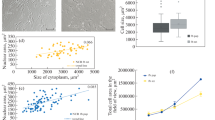Summary
A special type of fibroblast is observed in the connective tissue of seminiferous tubules in human testes. These cells are characterized by a fibrillar system consisting of parallel arranged cytoplasmic filaments. The filaments have a mean diameter of 80 Å. Bundles of filaments run parallel to the surface of the flattened cells. The filaments insert in a dense, granular material which is connected with the cell membrane. This fibrillar system is thought to be contractile; the dense or more loose texture of the filaments within the bundles may correspond to the contracted or relaxed state of the cell. The specialized fibroblasts described are supposed to belong to the group of myofibroblasts (Gabbiani, Ryan and Majno, 1971).
Zusammenfassung
In der Lamina propria menschlicher Hodenkanälchen wurden spezialisierte Fibroblasten beobachtet. Die Zellen sind durch Bündel parallel geordneter Plasmafilamente gekennzeichnet, deren Durchmesser rund 80 Å beträgt. Die Filamentbündel verlaufen parallel zur Oberfläche der lamellär ausgebreiteten Zellen und inserieren in elektronendichtem, granulärem Material, das der Innenseite der Zellmembran anliegt. Es wird angenommen, daß dieses Fibrillensystem kontraktil ist; die dichtere oder lockerere Vernetzung der Filamente innerhalb der Bündel würde dem kontrahierten oder erschlafften Zustand der Zellen entsprechen. Die beschriebenen spezialisierten Fibroblasten sollten der Gruppe der Myofibroblasten zugeordnet werden (Gabbiani, Ryan und Majno, 1971).
Similar content being viewed by others
Literatur
Danneel, S.: Identifizierung der kontraktilen Elemente im Cytoplasma von Amoeba proteus. Naturwissenschaften 51, 368–369 (1964).
Gabbiani, G., Hirschel, B. J., Ryan, G. B., Statkov, P. R., Majno, G.: Granulation tissue as a contractile organ. A study of structure and function. J. exp. Med. 135, 719–734 (1972).
Gabbiani, J., Majno, G.: Dupuytren's contracture: Fibroblast contraction? Amer. J. Path. 66, 131–146 (1972).
Gabbiani, G., Ryan, G. B., Majno, G.: Presence of modified fibroblasts in granulation tissue and their possible role in wound contraction. Experientia (Basel) 27, 549–550 (1971).
Güldner, N.: Spezialisierte Fibroblasten im kontraktilen System der Duodenalzotte. Demonstration bei der 67. Versammlung der Anatomischen Gesellschaft in Köln, 20. bis 24. März 1972.
Hirschel, B. J., Gabbiani, G., Ryan, G. B., Majno, G.: Fibroblasts of granulation tissue: Immunofluorescent staining with antismooth muscle serum. Proc. Soc. exp. Biol. 138, 466–469 (1971).
Huxley, H. E.: The mechanism of muscular contraction. Science 164, 1356–1366 (1969).
Karnovsky, M. J.: A formaldehyde-glutaraldehyde fixative of high osmolality for use in electron microscopy. J. Cell Biol. 27, 137A-138A (1965).
Keyserlingk, D. Graf: Über die Bedeutung des intracellulären, kontraktilen Systems für die Lokomotion der Fibroblasten. Cytobiologie 1, 259–272 (1970).
Komnick, H., Stockem, W., Wohlfarth-Bottermann, K. E.: Ursachen, Begleitphänomene und Steuerung zellulärer Bewegungserscheinungen. Fortschr. Zool. 21, Heft 1 (1972).
Leeson, C. R., Leeson, T. S.: The postnatal development and differentiation of the boundary tissue of seminiferous tubule of the rat. Anat. Rec. 147, 243–259 (1963).
Luft, J. H.: Improvements in epoxy resin embedding methods. J. biophys. biochem. Cytol. 9, 409–414 (1961).
Majno, G., Gabbiani, G., Hirschel, B. J., Ryan, G. B., Statkov, P. R.: Contraction of granulation tissue in vitro: similarity with smooth muscle. Science 173, 548–549 (1971).
Moss, N. S., Benditt, E. P.: Spontaneous and experimentally induced arterial lesions. I. An ultrastructural survey of the normal chick aorta. Lab. Invest. 22, 166–183 (1970).
Moss, N. S., Benditt, E. P.: The ultrastructure of spontaneous and experimentally induced arterial lesions. II. The spontaneous plaque in the chicken. Lab. Invest. 23, 231–245 (1971).
O'Shea, J. D.: An ultrastructural study of smooth muscle-like cells in the theca externa of the ovarian follicles in the rat. Anat. Rec. 167, 127–131 (1970).
Roosen-Runge, E. C.: Motions of the seminiferous tubules of rat and dog. Anat. Rec. 109, 413 (1951).
Schäfer-Danneel, S., Weissenfels, N.: Licht- und elektronenmikroskopische Untersuchungen über die ATP-abhängige Kontraktion kultivierter Fibroblasten nach Glycerinextraktion. Cytobiologie 1, 85–98 (1969).
Author information
Authors and Affiliations
Rights and permissions
About this article
Cite this article
Böck, P., Breitenecker, G. & Lunglmayr, G. Kontraktile Fibroblasten (Myofibroblasten) in der Lamina propria der Hodenkanälchen vom Menschen. Z.Zellforsch 133, 519–527 (1972). https://doi.org/10.1007/BF00307132
Received:
Issue Date:
DOI: https://doi.org/10.1007/BF00307132




